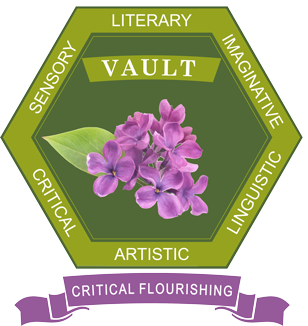April is the cruellest month, breeding Lilacs out of the dead land, mixing Memory and desire, stirring Dull roots with spring rain. (from T.S. Eliot "The Waste Land")
Although the major is called Theory of Literature, the course is broader than this, overlapping with aesthetics and cultural studies and culminating in the third and Honours levels with Critical Theory. Since a distance e-learning course dedicated to texts and theory can be a bit dry and abstract, we have developed an imaginative "shell" for the course, and created the Virtual African University of Literary Theory (VAULT) with its own emblem and motto, "Critical Flourishing". Click on the various levels of the building to obtain an overview of the major as a whole. Taking the word "lilacs" from T.S. Eliot's poem "The Waste Land", we have used it as an acronym to specify those capacities the flourishing of which is the aim of the course. "The Waste Land" is a prime example of intertextuality in literature and has itself become an intertext in other media such as the musical composition by Manos Hadjidakis, "Lilacs out of the dead land".
The first three terms - literary, imaginative and linguistic - are very closely related, since literature is a special, imaginative form of language. Linguistics is an important component of modern literary theories, many of which take the Swiss linguist Ferdinand De Saussure's Course in General Linguistics as their point of departure. Although Romantic theorists made claims for the imagination that seem extravagant today, this faculty remains central to the creation and appreciation of fiction, drama and poetry. Indeed, quite recently, J.M. Coetzee has promoted the sympathetic imagination in literature as an important ethical capacity.
Concerning the last three terms - artistic, critical and sensory - art can refer both to aesthesis (perception) and poiesis (creation or making), that is, both to receptive and productive capacities. In fact, the Theory of Literature course is closely bound up with the Creative Writing course - they are designed to reinforce each other. The final capacity, the sensory (or sense perception), refers to the aesthesis aspect of art, the shift of emphasis from aesthetic object to the subjective aesthetic experience. An important aim of the course is to empower you to perceive the world in new ways. While the course should develop your critical faculties throughout, the ultimate flourishing of these capacities culminates in the third level and Honours modules, which involve Critical Theory. A critical essay on epistemology, research traditions and schools of thought can be found on Level 4 under the honours module HMATL80 (Research Methodology)

